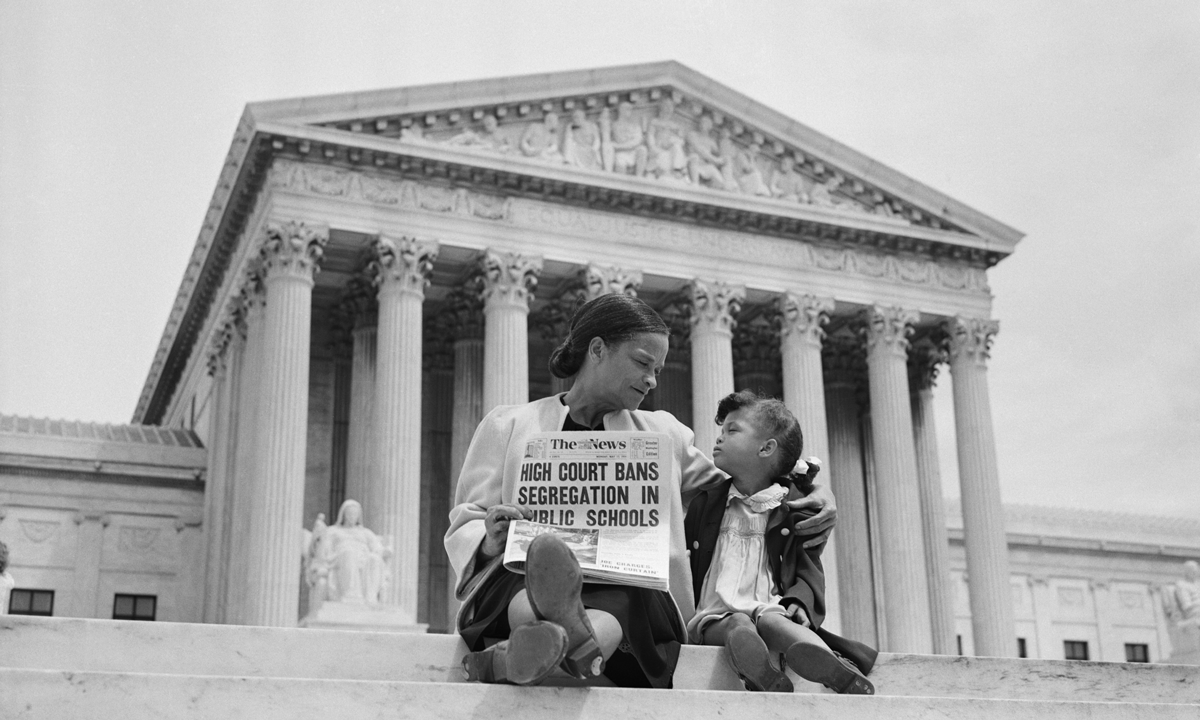Segregation Forever? What Supreme Court Failed to Do in ‘Brown v. Board’ Ruling
DeRoche: The nation needs better laws to ensure the public schools are, in the words of the landmark ruling, 'available to all on equal terms.'

Get stories like these delivered straight to your inbox. Sign up for The 74 Newsletter
On May 17, 1954, the Supreme Court ruled that it is unconstitutional to segregate children by race in the public schools. Now, 70 years later, it is time for the country to reckon with Brown v. Board of Education.
For years now, it’s been conventional wisdom that the legacy of Brown is, at best, complicated and possibly even an outright failure. On the one hand, it ended the evil practice of sorting kids into schools by race. By citing the Constitution in seeking to end this once-common policy, the justices reimagined the American social contract and marked a hugely important milestone for the country. On the other hand, despite optimistic predictions, the public schools remain starkly divided along racial and class lines.
Read Brown now, and you can see that the contradiction was there right from the beginning. The court lamented the impact that racially isolated schools can have on children of color, but the ruling itself didn’t outlaw racial imbalances. It simply made it illegal to assign kids to school based on their race. In later cases, the court explicitly declined to outlaw the racial imbalances that arise indirectly from policies that do not mention race.
This was the right call. Had the court done so, school districts would have been empowered to engage in social engineering on a revolutionary scale. Kids would have been reassigned to schools with the singular goal of eliminating any racial disparities in enrollment, leading districts to ignore all the other factors that might determine which school is the best fit for which child: size of the school, convenience of location, values, curricular focus, pedagogical approach, etc. This would have been a disaster for the country, and low-income kids of all races would have become pawns in a radical social experiment.
However, by defining the constitutional violation so narrowly, the court limited its jurisdiction to those districts that had a history of explicit racial segregation. Only they would be forced to end racial imbalances in their schools. And even in these cases, the courts’ scrutiny would end as soon as a district was found to have atoned for the sins of its past.
In effect, the court boxed itself into a corner that keeps getting smaller. Even as districts have stricken any mention of race from their school assignment policies, racial divisions have persisted or even worsened. Why? Because children are primarily assigned to schools based on their address, and American cities are largely divided along lines of race and income level, even within the same neighborhood. So schools come to mirror those imbalances. What’s more, the bundling of housing and education has driven up the cost of homes near elite, coveted public schools, further exacerbating these longstanding inequalities.
Today, Linda Brown, the little girl who gave her name to the landmark 1954 case, wouldn’t be turned away from a public school because of her race. Instead, she’d likely be rejected because of her address. I fear that’s no great improvement.
Take a look at elite, coveted public schools across the country, like Lincoln Elementary in Chicago. Or Mary Lin Elementary in Atlanta. Or Mount Washington Elementary in Los Angeles. The attendance zones of such schools often mirror racist redlining maps of their neighborhoods from the New Deal era. In effect, the zones are doing the same work that redlining did back in the 1930s and 1940s, boxing out low-income families of all races. Call it educational redlining.
The courts have decided that they are powerless to deal with these issues, even though these policies violate the clear language of Chief Justice Earl Warren’s 1954 opinion, which declared that public schools “must be made available to all on equal terms.” This is the forgotten promise of Brown.
My organization, Available to All, has just released a 50-state report titled “The Broken Promise of Brown v. Board of Ed.” Looking at the laws that govern public school admissions, our report found that American families have very weak legal protections governing access to public schools. Legal discrimination based on geography or income is common, while neutral enrollment policies like lotteries are required only in rare cases, for example in charter school admissions.
This leaves schools free to use a home address or family income level to turn a child away. Lack of oversight means school staff can play games with waitlist and admit one family over another. Finally, the laws are riddled with inconsistencies and loopholes, meaning parents have to navigate a system in which the rules vary from school to school. Some public schools are required to have lotteries; others are not. Some are required to use exclusionary school zones to turn kids away; others are forbidden to do so.
We call on policymakers and the courts to bring much-needed oversight to public school enrollment. That means providing procedural protections for American families applying to public schools, including a right to apply to any public school, regardless of their address, and an appeals process for challenging schools that deny a child enrollment. State law should require schools to collect and publish data like acceptance and denial rates. And — perhaps most importantly — there need to be legal reforms that reduce the importance of exclusionary maps, by, for example, requiring that public schools reserve 15% of their seats for children who live outside their zone or district.
It’s time to take action and finally, after 70 years, fulfill the promise that Brown made.
Get stories like these delivered straight to your inbox. Sign up for The 74 Newsletter


